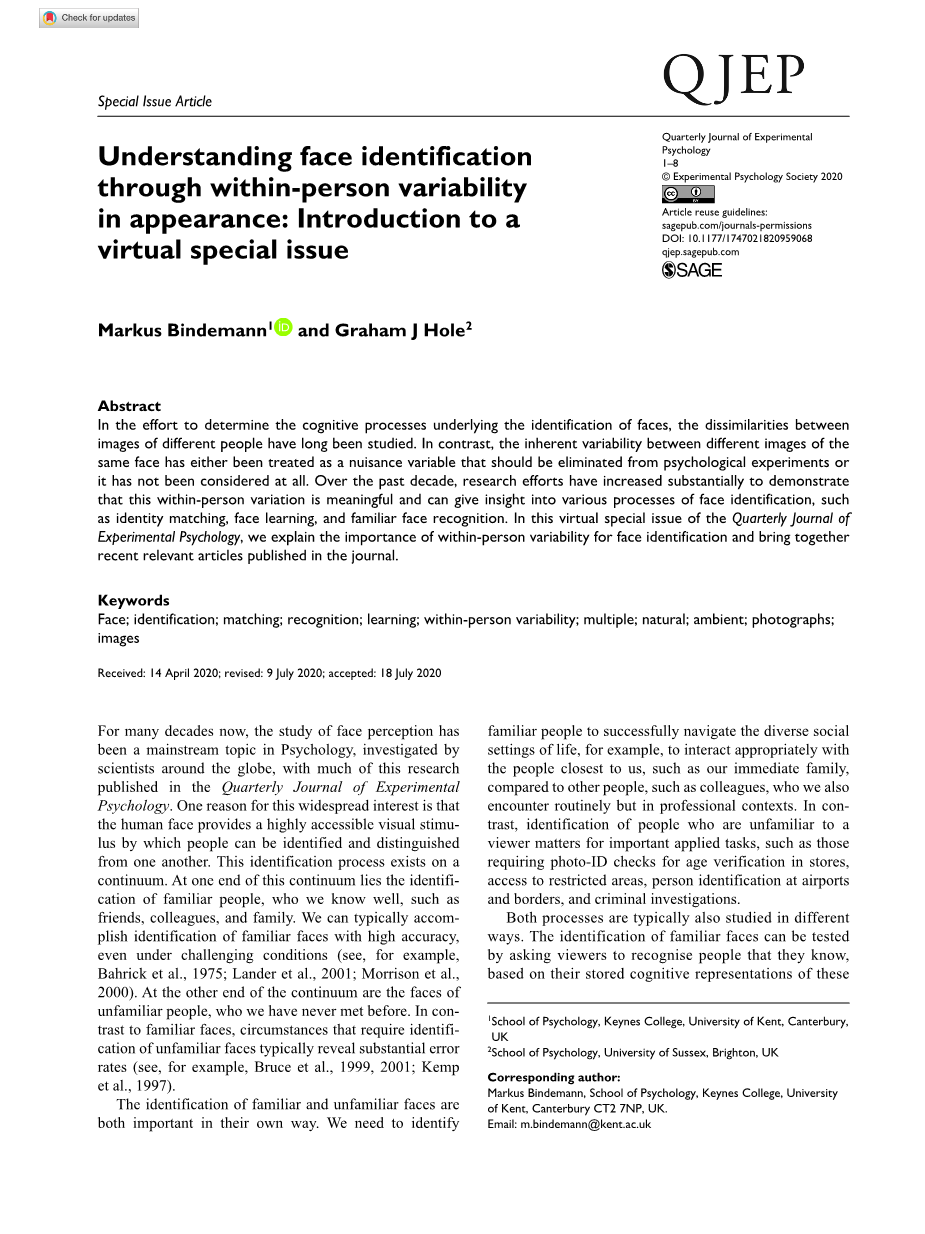

英语原文共 8 页,剩余内容已隐藏,支付完成后下载完整资料
英文原文:
Special Issue Article
Understanding face identification through within-person variability in appearance: Introduction to a virtual special issue
Markus Bindemann and Graham J Hole
Abstract
In the effort to determine the cognitive processes underlying the identification of faces, the dissimilarities between images of different people have long been studied. In contrast, the inherent variability between different images of the same face has either been treated as a nuisance variable that should be eliminated from psychological experiments or it has not been considered at all. Over the past decade, research efforts have increased substantially to demonstrate that this within-person variation is meaningful and can give insight into various processes of face identification, such as identity matching, face learning, and familiar face recognition. In this virtual special issue of the Quarterly Journal of Experimental Psychology, we explain the importance of within-person variability for face identification and bring together recent relevant articles published in the journal.
Keywords
Face; identification; matching; recognition; learning; within-person variability; multiple; natural; ambient; photographs; images
Received: 14 April 2020; revised: 9 July 2020; accepted: 18 July 2020
For many decades now, the study of face perception has been a mainstream topic in Psychology, investigated by scientists around the globe, with much of this research published in the Quarterly Journal of Experimental Psychology. One reason for this widespread interest is that the human face provides a highly accessible visual stimulus by which people can be identified and distinguished from one another. This identification process exists on a continuum. At one end of this continuum lies the identification of familiar people, who we know well, such as friends, colleagues, and family. We can typically accomplish identification of familiar faces with high accuracy, even under challenging conditions (see, for example, Bahrick et al., 1975; Lander et al., 2001; Morrison et al., 2000). At the other end of the continuum are the faces of unfamiliar people, who we have never met before. In contrast to familiar faces, circumstances that require identification of unfamiliar faces typically reveal substantial error rates (see, for example, Bruce et al., 1999, 2001; Kemp et al., 1997).
The identification of familiar and unfamiliar faces are both important in their own way. We need to identify familiar people to successfully navigate the diverse social settings of life, for example, to interact appropriately with the people closest to us, such as our immediate family, compared to other people, such as colleagues, who we also encounter routinely but in professional contexts. In contrast, identification of people who are unfamiliar to a viewer matters for important applied tasks, such as those requiring photo-ID checks for age verification in stores, access to restricted areas, person identification at airports and borders, and criminal investigations.
Both processes are typically also studied in different ways. The identification of familiar faces can be tested by asking viewers to recognise people that they know, based on their stored cognitive representations of these identities in memory. In its simplest form, recognition of familiar faces in psychological experiments can be tested by presenting a single photograph of a person and by asking participants to decide whether or not this person is familiar (Young et al., 1985), by asking them to name the person (Russell et al., 2009), or to classify faces based on stored semantic information such as occupation and nationality (Bindemann et al., 2005). In contrast, direct means to examine the identification of unfamiliar faces are visual matching tasks, in which observers have to decide whether two side-by-side faces depict the same person or different people (Burton et al., 2010; Fysh amp; Bindemann, 2018), or lineup tasks, in which a target has to be identified from among a set of faces (Bindemann et al., 2012; Bruce et al., 1999; Megreya amp; Burton, 2008).
These processes are clearly also linked, as every face that we know was once unfamiliar to us. Bridging the divide on the continuum between unfamiliar and familiar face identification is the process of face learning. In typical learning paradigms, observers are initially exposed to unfamiliar faces in photographs, videos, or during live interaction. The successful encoding and storage of such newly learned faces can then be tested directly, for example, with paradigms that require old or new decisions to photographs of faces (Bruce, 1982; Hill et al., 1997; Longmore et al., 2008), or indirectly, by looking for an advantage for learned over novel faces in tasks such as face matching (Bruce et al., 2001; Clutterbuck amp; Johnson, 2002, 2004; Megreya amp; Burton, 2006, 2007).
While familiar and unfamiliar face identification have now been researched extensively in Psychology, an important step-change has occurred in recent years in how these processes are studied. Traditionally, the study of face identification has relied on using controlled images of faces. For example, faces are often shown in a frontal view, with a neutral expression and under even lighting, and cropped to remove extraneous characteristics, such as hair and the image background. The rationale for such image manipulations is to remove “noise” from stimulus sets that might interfere with the controlled study of cognitive processes under laboratory conditions
剩余内容已隐藏,支付完成后下载完整资料
资料编号:[258311],资料为PDF文档或Word文档,PDF文档可免费转换为Word
以上是毕业论文外文翻译,课题毕业论文、任务书、文献综述、开题报告、程序设计、图纸设计等资料可联系客服协助查找。


